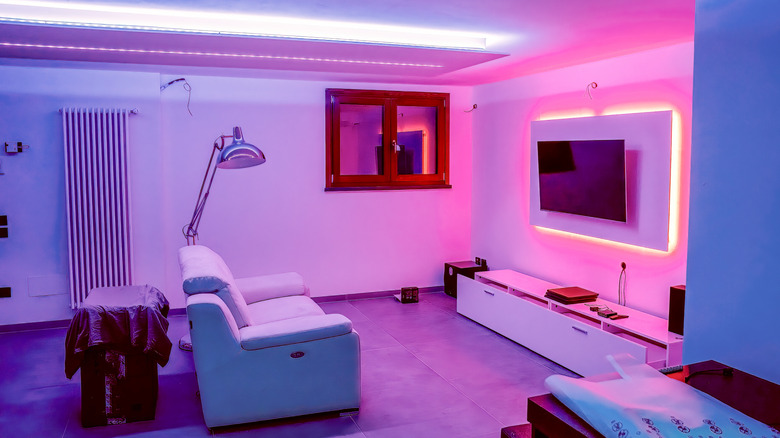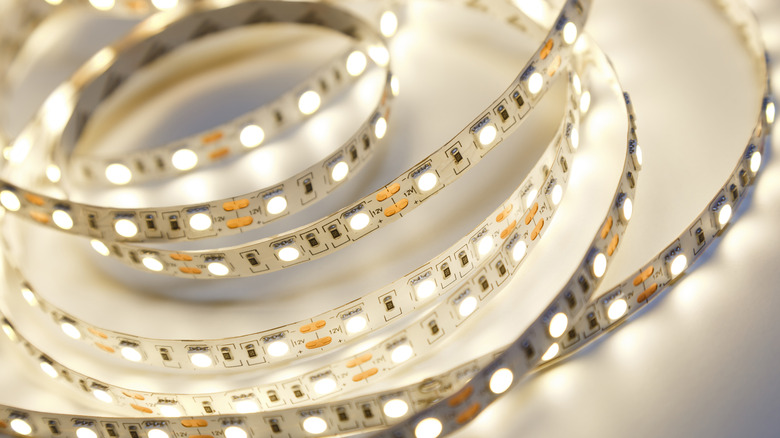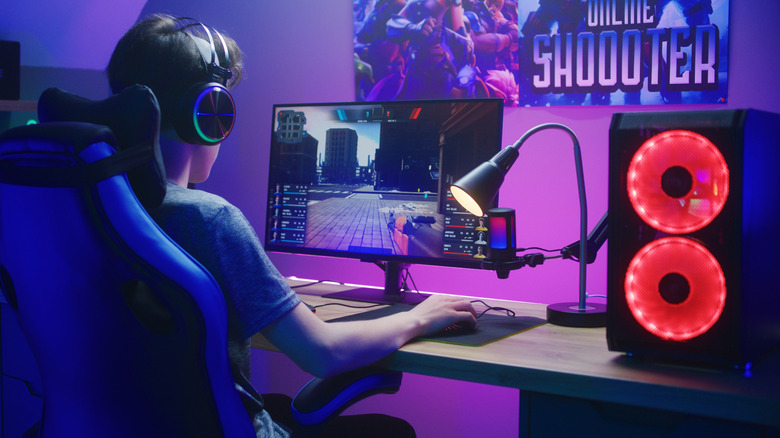Why You Might Want To Stick LED Strip Lights Behind Your TV
There seems to be more and more talk about lighting, whether it's blue light from screens, red light therapy, smart bulbs, or LED light strips for custom interior lighting. These days almost every living room has a TV of some sort, so marrying the lighting and vibe of your favorite room to the screen you're watching makes sense. Enter bias lighting. This involves taking a light source — often an LED strip — and placing it behind a flat-screen television or computer monitor to optimize the viewing experience in the evening.
In doing so, users are able to create a soft ambient radiance that extends beyond the borders of their television. In turn, it illuminates the room itself, adding to the mood, and creating a unique, inviting atmosphere. Some also claim a reduction in eye strain with the right setup, a modern-day problem stemming from being fixed to our screens far too often.
Of course, this is subjective and done to one's taste and may not appeal to everyone. It's also considered a niche trend, without many studies backing its clinical effectiveness. Despite this, there are many fans of customized bias lighting.
Benefits and aesthetics
You've probably seen the massive influx of LED lightbulbs and light strips that have flooded the market in recent years. Many homeowners have opted to switch out their old incandescent bulbs in favor of this newer tech. There are myriad of reasons to embrace LED bulbs and light strips, with bias lighting being one of them. LED technology keeps improving, much like that of modern televisions. However, we all know that monitors, smartphones, and TVs emit blue light, which can allegedly disrupt circadian rhythms.
Many TVs have automatic dimming features, and there are apps like Flux that claim to reduce blue light, reducing eye strain and aiding sleep. It's hard to say if these things help, but experiencing eye strain can be problematic for some. Bias lighting fans often claim that it reduces eye strain, while watching TV and working at a computer. One Reddit user claims that it makes the black portions of the screen appear blacker, offering higher contrast and better viewing. However, this could be a placebo and is subjective from person to person.
Bias lighting for many simply improves the aesthetics of a room in general, offering dramatic nighttime viewing with intentional, strategically placed lighting, creating a diffused halo around screens. The option to change colors and intensity for further nuance is a bonus. Brands like Philips and Govee offer smart lighting options to create immersive atmospheres, allowing you to customize lighting with millions of colors.
Optimizing your own setup
The strips themselves come with adhesive backing, so you can stick them to flat surfaces like the back of a television. They can be sourced in packs with interlocking sections, allowing for further customization. Users typically adhere the strips to the rear, outer edge of the screen, measuring all sides beforehand. Aiming the lights away from the screen will create the desired diffuse effect. The next project consideration is white versus RGB strips, per your preferences. Natural white allows for subtle backlighting, without the spectacle or novelty of colors.
Some may prefer this over RGB or dynamic color-changing lights, opting for a more traditional, warm ambiance. Others might prefer the immersion that multi-color LED strips offer, with deep hues of pink, purple, red, you name it. A bias lighting setup shouldn't exceed 10% of a display's maximum brightness. Some find 5% to be the sweet spot. Another factor to consider is the color of the wall behind the viewing screen. Neutral and matte colors are usually preferred, as they diminish shifts in color and reflections from the screen.
TV placement is critical, and they should never be put in front of windows. Shiny surfaces like mirrors and big windows without the cover of curtains can also disrupt the viewing experience. In a perfect scenario, bias lighting rooms would be free of reflective surfaces and have walls with neutral, matte paint. Lastly, powering the strips is typically done via USB, and proprietary apps enable full control.


